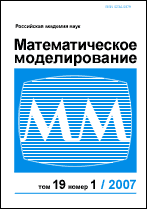|
This article is cited in 22 scientific papers (total in 22 papers)
The monitoring state of a moving train using high performance systems and modern computational methods
I. B. Petrov, A. V. Favorskaya, N. I. Khokhlov, V. A. Miryaha, A. V. Sannikov, V. I. Golubev
Moscow Institute of Physics and Technology
Abstract:
The aim of this work is to study the propagation of elastic waves in the rail. The comparative analysis of the calculation obtained by the grid-characteristic method and by the discontinuous Galerkin method was done. The comparison of the elastic waves' propagation in the presence and absence of a cavity in the ground of the railway embankment was made as well. The comparison of the signals diagnosed in these cases in the rail was done. Also the wave pattern and diagnosed signals for the four types of defects in the rails are shown: vertical and horizontal separation of the rail head, transverse cracks in the rail head and the cracks in the rail neck.
The grid-characteristic method on curvilinear structural meshes and the discontinuous Galerkin method on unstructured triangular meshes provide to meet the challenges of the monitoring of the state of rolling stocks and railways effectively, including taking into account the large amount of violations the integrity, to take into account the dynamic interaction in the system "the rolling stock–the railway", to get a complete wave pattern.
Keywords:
grid-characteristic method, discontinuous Galerkin method, defectoscopy, monitoring of the rolling-stocks, numerical simulation.
Received: 27.05.2013
Citation:
I. B. Petrov, A. V. Favorskaya, N. I. Khokhlov, V. A. Miryaha, A. V. Sannikov, V. I. Golubev, “The monitoring state of a moving train using high performance systems and modern computational methods”, Matem. Mod., 26:7 (2014), 19–32; Math. Models Comput. Simul., 7:1 (2015), 51–61
Linking options:
https://www.mathnet.ru/eng/mm3494 https://www.mathnet.ru/eng/mm/v26/i7/p19
|

| Statistics & downloads: |
| Abstract page: | 402 | | Full-text PDF : | 97 | | References: | 56 | | First page: | 41 |
|




 Contact us:
Contact us: Terms of Use
Terms of Use
 Registration to the website
Registration to the website Logotypes
Logotypes








 Citation in format
Citation in format 
